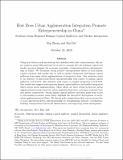How does urban agglomeration integration promote entrepreneurship in China? Evidence from regional human capital spillovers and market integration
Author(s)
Du, Rui; Zheng, Siqi
DownloadSubmitted version (3.280Mb)
Publisher with Creative Commons License
Publisher with Creative Commons License
Creative Commons Attribution
Terms of use
Metadata
Show full item recordAbstract
Using firm birth records and startup data matched with cities' characteristics, this paper analyzes nearly 300 prefecture-level cities to examine the role of human capital and market access in shaping the economic geography of innovation-driven entrepreneurship in China. We document strong positive entrepreneurial effects of local human capital resources and market size as well as market integration and human capital spillovers from mega-urban agglomerations of integrated cities. Our estimates point to an elasticity of innovation-driven entrepreneurship with respect to human capital spillovers of 0.50–0.79. The elasticity with respect to market integration is 0.53–0.89. Our results also suggest heterogeneous human capital spillover and market integration effects across urban agglomerations. These effects are more robust in first-tier urban agglomerations because first-tier urban agglomerations have a stronger economic base and greater connectivity. Strong human capital spillover and large gains from access to surrounding economic mass jointly highlight the integrated development of mega-urban agglomerations in China. We discuss policy implications that concern promotion of local innovation-driven entrepreneurship by strengthening intercity coordination, building transportation and social infrastructure, and improving urban management.
Date issued
2020-02Department
Massachusetts Institute of Technology. Department of Urban Studies and PlanningJournal
Cities
Publisher
Elsevier BV
Citation
Zheng, Siqi and Rui Du. "How does urban agglomeration integration promote entrepreneurship in China? Evidence from regional human capital spillovers and market integration." Cities 97 (February 2020): 102529 © 2019 Elsevier Ltd
Version: Original manuscript
ISSN
0264-2751